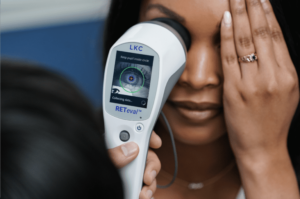ERG protocol continues to expand


Late last year, I decided to invest in a handheld ERG unit. Prior to that, on rare occasions, I would refer patients for ERG testing, but I would struggle to interpret the meaning of the results when they came back. That’s one reason why the buzz about the RETeval® device from LKC Technologies caught my attention. It’s handheld, fast, affordable, and the easy-to-read report it generates provides the clear information I need for decision-making. Fast forward to today—a mere six months after opening the box—and I can’t imagine practicing without my RETeval. While the list of benefits that the device extends to me, my patients, my staff and my practice is long, there are three things that really stand out.
1. It’s easy to implement due to the very minimal learning curve
Any time you add new technology, you need to develop a protocol that works for your unique practice setting. The implementation process with the RETeval device was unique—in a good way. The fact that it’s fast and portable goes a long way toward not being too disruptive to existing routines. It’s also a breeze for patients, unlike other functional tests, such as visual fields, which many patients find to be stressful. Also, patients often want to know why a test is being recommended. With some technologies, it can be difficult for staff to articulate our clinical rationale. With ERG, it’s simple. We provide an EKG analogy: The ERG is to the eye what the EKG is to the heart. I find it ironic that this analogy sits well with patients, but not as well with doctors since it makes us think of wires and electrodes and complex readouts that we struggled to interpret in optometry school and considered to be far too impractical for use in real-life practice. The RETeval device is absolutely nothing like the ERG of my nightmares. In fact, this test is so easy that every single one of my technicians say it’s easy to perform.


The one aspect of implementation was determining which patients will get the test. Diabetes, glaucoma, macular degeneration are the diseases where I started, but I have expanded to test patients who have unexplained decreased vision and patients who have cataracts to see structures of optic nerve and retina. In fact, I’m still adding to this pool of patients thanks to colleagues who educate me to the diverse benefits of ERG testing. It’s remarkable how much information you can glean across multiple disease presentations.
2. It gives me peace of mind that I otherwise wouldn’t have without over-referring
Because, historically, ERG wasn’t very user-friendly, I resisted investing in my own unit. This left me with two options for patients who I felt could really benefit from the test. I could either “do nothing” or I could send patients to a colleague who would then send me back a report. More often than not, I did the latter. The challenge with this strategy was that the report itself was not user-friendly and, because I wasn’t referring unless the patient already had reduced vision that I couldn’t explain, I was unfamiliar with the readout and would have to reeducate myself every time I reviewed the findings. So, when I first saw the RETeval report, it caught my eye because it was so much simpler to interpret compared to what I was used to seeing. The diabetic retinopathy score and report even color codes the findings—red, yellow and green. It couldn’t be more straight-forward.


I see a lot of diabetic patients and, far too often, their structural findings don’t align with what I see functionally. I find this puzzling scenario unsettling and it frustrates me when things aren’t adding up. I worry that I’m just waiting for the next exam—whenever that might be—to potentially reveal something I wish I knew sooner. Most of that angst is gone now because I have a critical piece of information about retinal function that my technician collected in a matter of minutes and that I could read within seconds.
3. It’s a completely objective test that benefits both patients and eye care providers
I am a firm believer in collecting both structural and functional measures. In high-risk patients who have diabetes, it’s my responsibility to get a very clear understanding of what’s happening physiologically and how the patient’s retinal cells are responding functionally. Only then will I have a complete picture and the confidence to set exam intervals, make referrals, or order additional testing. That said, our ability to reliably measure function has been strikingly limited. Most practices have only two ways to measure function: visual acuity and visual fields. Unfortunately, both of these measures rely on patient response, which can have a big impact on results since sometimes patients try hard for you, and sometimes they don’t—or can’t. Furthermore, despite being subjective and with variable repeatability, functional tests—while necessary and useful—can eat up a significant amount of everyone’s time. That’s why, when I first learned about the RETeval device, it sounded too good to be true. It meant I could get a reliable, objective result quickly and easily. This was a real game-changer for my practice that gives us so much more flexibility and information.
Although you can schedule patients for a follow-up visit to perform ERG, if you want answers on the spot, it’s very simple to obtain them. In a single visit, you can put the puzzle together, without worrying about how soon you’ll see the patient back. There are also times when a patient’s vision isn’t where it should be, and my structural tests don’t always help me understand why. Before ERG, even my seemingly comprehensive assessment of the patient was limited. The RETeval device gives me the objective missing puzzle piece that I need to make sense of a diagnosis, manage patients, and monitor progression with retinal or optic nerve disease.
Incorporating ERG into my practice is a work in progress because, with each passing day, I become increasingly reliant on the information that the RETeval device provides, especially knowing that the test is also reproducible. As I reflect on this, it gives me a sense of déjà vu of my first several years using OCT—a technology that I can’t imagine not having in my practice! The big difference with the RETeval is that it’s changing my protocols faster, in ways that benefit my patients, while making it much easier for me as a clinician.
Read other WO stories on LKC Technologies here.



